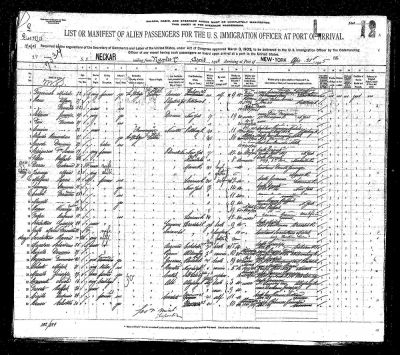We were very excited to introduce to you last month our new column, Discovering La Famiglia. The column’s author, Roslyn Torella, is a genealogist and a family historian. Her grandparents hailed from Molise and Roslyn grew up in Lowellville, OH. She spends much of her writing time sharing stories of the history of her hometown and helping others find their ancestors. Roslyn is also a frequent contributing writer to La Gazzetta Italiana. Discovering La Famiglia is meant to act as a step-by-step guide to aid readers in researching your family history. We hope that this column is a useful guide to many of you! And, we would love to hear how your research is going! Please share your stories with us at This email address is being protected from spambots. You need JavaScript enabled to view it..
For many of us Italian Americans, our families have been in the U.S. for over a century and as a result, our original Italian surnames may have become “Americanized.” Knowing your family’s original surname is important for documenting your family history and unlocking where your forbearers came from in Italy. Unfortunately, there may be no one still alive in our families who remember what the Italian surname was. This column will provide some tips on how to find your Italian cognome (surname).
Before we get into the tips, it is important to dispel a myth that immigration officials changed foreign surnames. This is simply not true. First, the names of all immigrants beginning about 1820 were documented on ship manifests that were completed in their country of origin, by individuals who were familiar with the language. Second, immigration officials in places like Ellis Island were fluent in foreign languages and had no need to change a name. The name changes came after our immigrant ancestors settled in America. The most common reason for a name change is simply that Italian names were often hard to pronounce and spell for English speakers. Therefore, you find a name like DiGiacomo becoming James or Napolitano becoming Napp. One interesting name change that I came across is the Catale family of Hillsville, PA who became the Kennedy family because their family home was near a train station called Kennedy! Sometimes the surname currently in use is a result of a misspelling that stuck, for example Perri becoming Perry. If a current surname has the letters J, K, W, X, or Y – it’s likely not to be an original surname as these letters are not part of the Italian alphabet.
Name changes usually occurred within the first few years of an immigrant’s arrival, so your best source for finding an original Italian surname will be on the earliest official records, such as ship manifests, petitions for naturalization, marriage records, or the earliest census records (provided that the census taker could understand your ancestor’s Italian accent). We will take a close look at each of these records and how to use them to find your ancestor’s original surname. However, this month our focus is on ship manifests.
New York was the most common landing port for Italian immigrants with an estimated 4.6 million Italians entering America through New York between 1855 and 1957. If your relative came to America via New York between 1855 and 1892, you can search Castle Garden (New York’s first official immigration station) records. For travelers who arrived after 1892 at New York, there is an Ellis Island website. Other common entry ports were Baltimore (1820-1948), Boston (1820-1891), Key West (1898-1957), New Orleans (1820-1945), Philadelphia (1800-1945), Tampa (1898-1945), and Wilmington NC (1898-1958). These other ports are searchable using Ancestry.com, Familysearch.org or JewishGen.org.
But when you don’t know an exact surname or which port to search, your best bet is to use the advanced search index at a website called JewishGen which allows you to search by town, year of arrival, age at arrival, etc. By entering pieces of information that you do know in your search, the resulting list can be examined for possible surnames. For example, if you know the village your ancestor came from, you would enter it in the search field. Since many of our ancestors came from small villages, having the ancestral village name is like a nugget of gold to help you narrow your search. Keep in mind that ship manifests were handwritten in the late 1890s and early 1900s and, as a result, there may be transcription errors when the manifests were transcribed for internet searching. Therefore, the resulting list may only give you an idea of the surname and you may have to use other records that will be described in future columns to corroborate your findings. The key is to be open minded, try different combinations of data that you do know in the search fields and compare results. When you view the results, take a close look at the manifest. It may show a final destination and the names of other family members. This information will help you determine if you have the right passenger.
On JewishGen, Ellis Island and Castle Garden searches are free as data is extracted from free databases, but for the other ports there may be a subscription fee. Look for the $ to determine which searches require you to subscribe to Ancestry.com to see results, as Ancestry’s database is the source. Happy ancestor hunting!
Here are the websites to help you get started:
Castle Garden (1855-1892 arrivals): http://castlegarden.org
Ellis Island (1892-1957 arrivals): http://libertyellisfoundation.org
Jewish Gen Advanced Search: http://jewishgen.org/databases/eidb/ellisgold.html (at the top of the screen is a drop-down field for you to choose which port to search)



